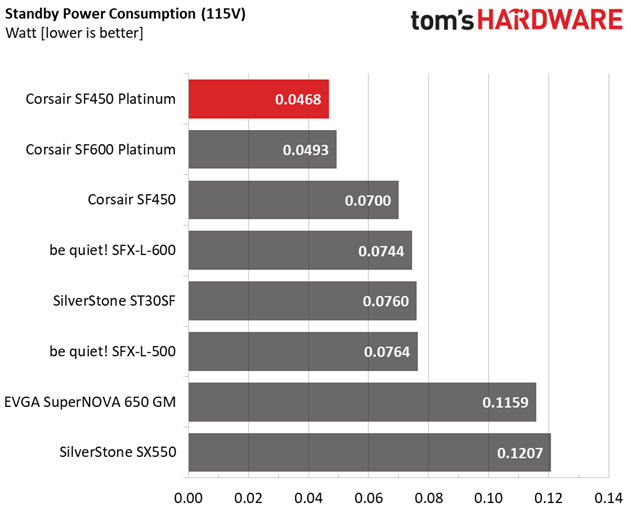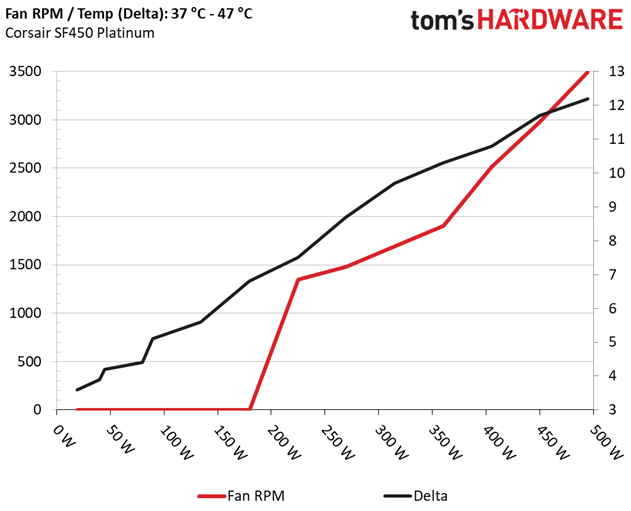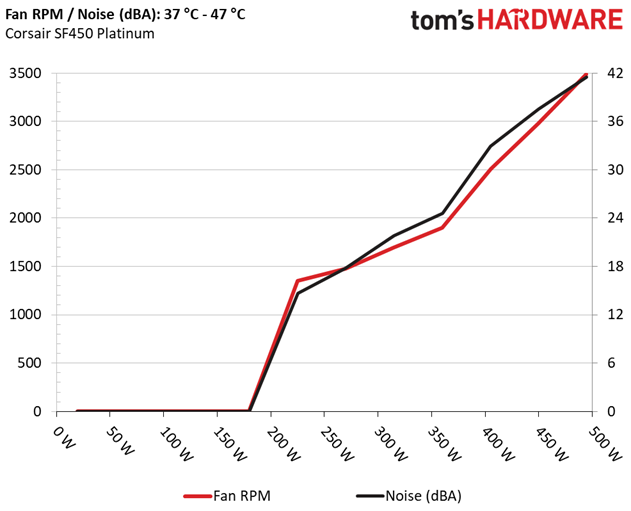Corsair SF450 Platinum SFX PSU Review: Best of the Best
Why you can trust Tom's Hardware
Efficiency, Temperature and Noise
Efficiency
Our efficiency testing procedure is detailed here.
Using results from the previous page, we plotted a chart showing the unit's efficiency at low loads, and loads from 10 to 110 percent of its maximum-rated capacity.




The SF450 Platinum only loses to its big brother under normal loads. Under light ones, it takes the lead with an almost 2% difference.
Efficiency At Low Loads
In the following tests, we measure the PSU's efficiency at loads significantly lower than 10 percent of its maximum capacity (the lowest load the 80 PLUS standard measures). The loads we dial are 20, 40, 60, and 80W. This is important for representing when a PC is idle, with power-saving features turned on.
| Test # | 12V | 5V | 3.3V | 5VSB | DC/AC (Watts) | Efficiency | Fan Speed | PSU Noise | PF/AC Volts |
|---|---|---|---|---|---|---|---|---|---|
| 1 | 1.199A | 0.496A | 0.478A | 0.198A | 19.545 | 76.404% | 0 RPM | <6.0 dB(A) | 0.755 |
| 12.050V | 5.039V | 3.346V | 5.045V | 25.581 | 115.06V | ||||
| 2 | 2.466A | 0.993A | 0.987A | 0.397A | 40.019 | 85.432% | 0 RPM | <6.0 dB(A) | 0.846 |
| 12.049V | 5.038V | 3.346V | 5.042V | 46.843 | 115.06V | ||||
| 3 | 3.660A | 1.488A | 1.464A | 5.038A | 59.490 | 88.148% | 0 RPM | <6.0 dB(A) | 0.892 |
| 12.048V | 5.037V | 3.345V | 5.038V | 67.489 | 115.06V | ||||
| 4 | 4.918A | 1.987A | 1.973A | 0.795A | 79.862 | 89.690% | 0 RPM | <6.0 dB(A) | 0.925 |
| 12.048V | 5.037V | 3.345V | 5.034V | 89.042 | 115.06V |
The efficiency levels achieved under light loads are jaw-dropping. Even with 20W, we measure over 76% efficiency. With 80W, our power analyzer shows an almost-90% reading.
5VSB Efficiency
The ATX specification (revision 1.4), along with CEC, ErP Lot 3 2014 and ErP Lot 6 2010/2013, states that 5VSB standby supply efficiency should be as high as possible, recommending 75 percent or higher with 550mA, 1A, and 1.5A of load. The PSU should also achieve higher than 75% efficiency at 5VSB under full load, or with 3A if its max current output on this rail is higher than 3A.
We take six measurements: one each at 100, 250, 550, 1000, and 1500mA, and one with the full load the 5VSB rail can handle.
Get Tom's Hardware's best news and in-depth reviews, straight to your inbox.
| Test # | 5VSB | DC/AC (Watts) | Efficiency | PF/AC Volts |
|---|---|---|---|---|
| 1 | 0.100A | 0.505 | 71.530% | 0.260 |
| 5.042V | 0.706 | 115.05V | ||
| 2 | 0.250A | 1.260 | 83.610% | 0.341 |
| 5.040V | 1.507 | 115.05V | ||
| 3 | 0.550A | 2.771 | 85.288% | 0.401 |
| 5.037V | 3.249 | 115.04V | ||
| 4 | 1.000A | 5.032 | 85.332% | 0.441 |
| 5.031V | 5.897 | 115.05V | ||
| 5 | 1.500A | 7.538 | 83.905% | 0.463 |
| 5.025V | 8.984 | 115.04V | ||
| 6 | 2.500A | 12.532 | 84.300% | 0.489 |
| 5.012V | 14.866 | 115.04V |


The SF450 Platinum obviously uses the same 5VSB circuit as its big brother. Thanks to the smaller parts it uses in certain circuits, which lead to lower energy losses, it achieves higher efficiency at 5VSB.
Power Consumption In Idle And Standby
In the table below, you'll find the power consumption and voltage values of all rails (except -12V) when the PSU is idle (powered on, but without any load on its rails), and the power consumption when the PSU is in standby mode (without any load, at 5VSB).
| Mode | 12V | 5V | 3.3V | 5VSB | Watts | PF/AC Volts |
|---|---|---|---|---|---|---|
| Idle | 12.095V | 5.050V | 3.348V | 5.044V | 5.185 | 0.499 |
| 115.1V | ||||||
| Standby | 0.047 | 0.027 | ||||
| 115.1V |


Both SF Platinum models consume very little vampire power. This is the safest way to achieve high efficiency at 5VSB under light loads.
Fan RPM, Delta Temperature, And Output Noise
Our mixed noise testing is described in detail here.
The first chart below illustrates the cooling fan's speed (in RPM), and the delta between input and output temperature. The results were obtained at 37°C (98.6°F) to 47°C (116.6°F) ambient temperature.
The next chart shows the cooling fan's speed (again, in RPM) and output noise. We measure acoustics from one meter away, inside a hemi-anechoic chamber. Background noise inside the chamber is below 6 dB(A) during testing (it's actually much lower, but our sound meter’s microphone hits its floor), and the results are obtained with the PSU operating at 37°C (98.6°F) to 47°C (116.6°F) ambient temperature.
The following graph illustrates the fan's output noise over the PSU's operating range. The same conditions of the above graph apply to our measurements, though the ambient temperature is between 30°C (86°F) to 32°C (89.6°F).
The semi-passive mode doesn't last long because we push the minor rails hard during these tests. Apparently, they need active cooling under high loads. But the fan profile is still relaxed overall, especially when we take this PSU's tiny size into account. The maximum noise output doesn't exceed 35 dB(A), and you have to push the unit with more than 420W to get there. That's close to its nominal capacity.
MORE: Best Power Supplies
MORE: How We Test Power Supplies
MORE: All Power Supply Content
Current page: Efficiency, Temperature and Noise
Prev Page Load Regulation, Hold-Up Time and Inrush Current Next Page Protection Features and DC Power Sequencing
Aris Mpitziopoulos is a contributing editor at Tom's Hardware, covering PSUs.



